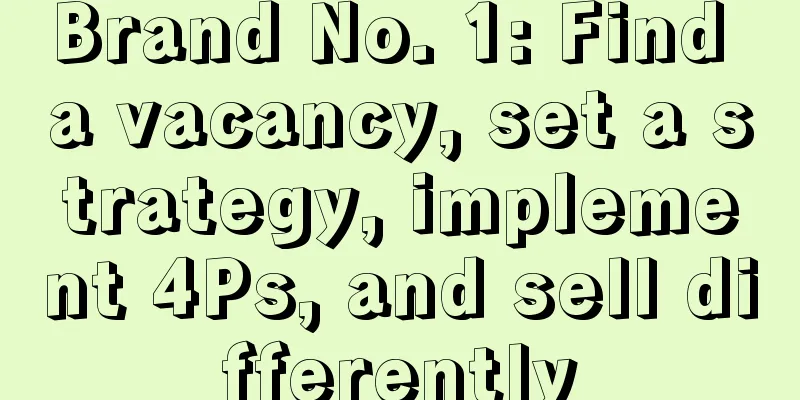Brand No. 1: Find a vacancy, set a strategy, implement 4Ps, and sell differently

1. Strategic Trichotomy1. Corporate StrategyThe resources of an enterprise are limited. The strategy at the enterprise (organization) level is first about what not to do and what to do. Choose what industry (track), what market opportunities to target, what business segment to do, and what product line to plan. That is: industry-market-business-product line 2. Market strategyYou can think of market strategy as drawing a "battle map". The enterprise strategy has already planned the industry, market, business, and product line, just like the food and soldiers are ready. How to fight this battle, which soldiers (products) to send out first, which hilltop (origin market) to occupy first, which soldiers to send out later, how to go from a point to a line, and then to a surface, and what kind of situation to form. 3. Brand strategyProducts occupy shelves, while brands occupy minds. The best strategy is to attack the enemy's strategy. Brand strategy is the best strategy. It means what kind of flag you should raise to command the world and conquer the world. How important is this flag? It is related to investment and can determine life and death. It comes down to: brand naming, product serial packaging, and differentiated reasons for purchase. For example, from the four stages of Xiangpiaopiao's development, we can see that the relationship between corporate strategy and brand strategy is:
As a brand, Xiangpiaopiao cup milk tea is successful, but as a business, Xiangpiaopiao Company is a failure. Fuji is also facing the decline of the film category, but it knows that at the corporate strategy level, it doesn't matter if this brand opportunity is lost, and it will look for other opportunities. After analyzing the resource capabilities formed by the company in the past, it discovered what the company's past capabilities for producing film were - fine chemicals, nano-synthesis, and collagen processing. Finally, we found medical uses for it, especially the processing of collagen, and even produced an anti-aging skin care product called Ashita, which sold very well - this is the result of separating corporate strategy from brand strategy. Equating brand strategy with corporate strategy, or even relying entirely on a brand to present corporate strategy, Xiangpiaopiao eventually died in the category change and was replaced by a new milk tea brand. The flag on the city wall changed frequently, and success or failure was all in vain. 2. Identify and occupy a competitive position - PositioningBusiness = Location = Positioning
For another example: For Mixue Bingcheng, this location is the ultimate cost-effectiveness created by the scale advantage of 10,000 channel stores (low itself is not a strategy, the low-price strategy based on scale advantage is the strategy). For Heyanyuese, which is also a milk tea brand, guarding Changsha is more valuable than fighting Wuhan, and becoming the representative of Changsha culture is an excellent position for Heyanyuese. From the perspective of industry, there are industry market price segments; from the perspective of categories, there are category differentiation and category characteristics; from the perspective of competition, there are previous waves and there will be more waves to come. Sun Tzu's Art of War says: If you know the place of war, you can fight a thousand miles away on the day of war. Knowing where to start a war and choosing where to start a war are more important than the action of starting a war. 3. Five-step method for vacanciesIf you look at the market, you will see crowded shelves and red oceans everywhere; if you look into the minds of consumers, you may find a blue ocean. The difference in cognition is far greater than the difference in reality. It is very difficult to establish an external cognitive perspective. Before Naitangpai, consumers did not know about a brand of large-cup bras, but that does not mean that other brands on the market do not have large-cup bras. This is a typical mental opportunity that exists in the market but is not known. First of all, "Positioning": The ultimate competition is in the mind, and the brand is a tool to occupy the mind. On this basis, there are three basic positioning principles: 1) leader positioning, 2) related positioning, and 3) repositioning (to competitors) The second is "Business Warfare": Four basic models, 1) offensive warfare, 2) defensive warfare, 3) flanking warfare, and 4) guerrilla warfare. The four basic business warfare models are based on competitors. This is what Sun Tzu said in the Art of War: Know yourself and know your enemy, and know your enemy (competitor). Then there is "Focus": All strategies inevitably involve trade-offs. The core of strategy is not war, but first of all strategic negligence. That is, only by not doing something can you do it well; by not doing something, you will have more energy to specialize in something, do it well, and do it thoroughly. By focusing on externally, you can occupy the "first place" and establish a sense of advantage; internally, you can multiply by subtraction and concentrate superior resources. Focus, focus - how much focus can be considered to have found the focus. For example: Fotile focused on high-end kitchen appliances and beat Siemens; Robam focused on strong suction and beat Fotile. On the one hand, too much is as bad as too little; on the other hand, if you take a hundred steps but only halfway through, you will not have finished the journey at all. This involves the question of the degree of focus. I think the degree of focus is roughly in three aspects: 1) competitors, 2) mental vacancies, and 3) the basis for advantages brought by corporate endowments. The essence of discussing the degree of focus is to return to the consumer side, because the core result of positioning is that the brand has a cognitive advantage. For this reason, the criterion for judgment is whether the company's focus has formed a clear, specific, and concrete cognitive advantage on the consumer side. For example: when XX brand is mentioned, XX product comes to mind; when XX product is mentioned, XX brand comes to mind first. From XX brand to XX product, and from XX product to XX brand, this unconscious reaction of consumers is the evaluation and quantity of degree. If you are afraid of getting angry, drink Wanglaoji. Finally, it comes down to "The Origin of Brands": Why is it the origin of brands? Because it answers the essential question and the ultimate question of brands - the parasitic matrix of brands is categories. The strength of brands is due to the matrix (categories), and the demise of brands is also due to the decline of the matrix (categories). You have to find the Mayflower to discover the New World, not the Titanic. This involves the understanding of form and momentum. Brand is form, and category is momentum. A good fighter seeks momentum, which is the category bonus and category vitality; this momentum is the force of brand awakening. We did nothing wrong, but we lost - Nokia. Nokia lost because of the demise of the feature phone category, and of course Motorola, Ericsson, and Blackberry. When someone loses, someone else wins. Apple won (new generation of smartphones) and won a great victory; Xiaomi won (direct sales smartphones) and Huawei won (first choice for business people). From feature phones to smartphones, foldable screens are another new opportunity. The strength of a brand lies in the replacement and iteration of its categories. Therefore, creating and leading a new category is the first choice of brand strategy or the best practice of brand strategy, because it finds a vacant position. Therefore, the degree of focus at this level can be understood as focusing on a clear, specific, and concrete category in the minds of consumers. Of course, it is necessary to distinguish between true categories and false categories; concrete categories and abstract categories. The core of the degree of strength is to form a clear cognition among consumers - occupying a vacant position. Therefore, the degree of focus is strength (product strength) and clarity (consumers). Strength refers to whether the company can release the energy of focus by multiplication after subtraction, and the other is to release the clarity of cognition on the consumer side. The clearer the clarity, the more powerful the vacancy will be. 4. 4P1. Product: Without product, nothing can be doneA combination of tangible and intangible things that meet consumer needs. Not only core products, form products, and additional products, the return to the source lies in the understanding of categories, characteristics, and differentiation.
——The core lies in the discovery, understanding and possession of category characteristics. The key to grasping category differentiation and creating hot-selling products lies in product strength. Product strength is essentially the ultimate embodiment of category characteristics in product functions and benefits.
Product triangle: naming, packaging, and dramatic reasons to buy When a company approaches you, don't say anything: first look and listen to whether the product's naming, packaging, and dramatic reasons for purchase are correct, good, and strong. Naming is not just about what the product is called, but also about what the company does; it is not just about the brand, but also about the thinking behind the category. Products can’t speak for themselves, good packaging can make the products speak for themselves Product packaging is the company's own media. When products are placed in channels and on shelves, rows and rows of products are the company's own free promotional media. Products cannot speak for themselves, so good packaging can make products speak for themselves. How to package? Package like a poster. If you enlarge it, it's a poster, and if you reduce it, it's packaging. Dramatic expression: reasonable and unexpected Dramatic purchase reasons are dramatic expressions of the core benefits, values, and differentiation of products. Simply stating the facts is not enough to impress people. The facts must be made more vivid, more interesting, and dramatically presented to effectively attract people's attention, reduce communication costs, and improve communication efficiency. In one sentence, it is: reasonable and unexpected. For example: I will not accept gifts during the Chinese New Year this year, and I will only accept Melatonin. Dramatization should be centered around the reasons for purchase. It is the dramatization of the reasons for purchase. Without the dramatic expression of the reasons for purchase, it becomes a creative advertisement. The goal is to make consumers remember the product, not the advertisement. This advertisement is really good, but it is all in vain. 2. Price: How do companies handle and distribute the interests of stakeholders?After the product comes the price, how much is the terminal price of the product, how much is the purchase price, and how is the distribution policy formulated. It is easier to understand pricing from the perspective of the Five Forces Analysis Model (Michael Porter), the bargaining power of suppliers, the bargaining power of buyers, the ability of potential competitors to enter, the substitution power of substitutes, and the current competitive power of competitors in the industry - the essence of pricing is how the company handles and distributes the interests of stakeholders. Stakeholders are not just consumers, but also the other four roles mentioned by Porter. If you don’t understand strategy, don’t touch price Pricing requires effort, which is not only marketing effort, but also business effort. Only from the perspective of business and corporate strategy can we dare to change the price. First-class entrepreneurs know how to set prices, because prices are an understanding of corporate strategy and organizational management internally, and they are used to deal with and distribute the interests of stakeholders externally. If you really do this job, you will be very nervous and terrified, just like taking the head of a general in the midst of thousands of troops. How to do it well? Understand prices from a more macro perspective. In essence, all prices should come from the understanding of corporate strategy. If you don’t understand strategy, don’t touch pricing. 3. Channel: After product and pricing comes channelChannels, also known as pathways, are the process by which products are transferred from manufacturers to consumers. The more intense the competition in channels, the finer the channels, and the more they are required to go down and sink. To establish broad and deep channels is to establish broad and deep channel relationships, and even more so, to establish large and strong channel policies and channel regimes. In essence, channels are relationships, channels are politics, and channels are regimes. 4. Promotion: The word promotion is not good, or our understanding of the concept of promotion is too narrow.It is not about promoting sales, but about stimulating sales. Including: advertising, public relations, sales promotion, and personnel promotion. It is a combination of punches, born and formed in harmony. Advertising is the most effective and the most expensive. It is effective because it is expensive. The market is fair. Generally speaking, it is impossible to be both ineffective and expensive. This is unscientific and does not conform to common sense. Once an advertisement is launched, it is worth a fortune. This saying will never be outdated. When others are not advertising, you should advertise; when others are advertising, you should advertise even more. You should keep advertising, and you should pursue and attack vigorously. Public relations, a good word, has been overused. Crisis public relations is not about public relations for crises, but about public relations for normal times. Public relations is a presentation held by an enterprise to the society and the industry. It is a confession meeting where one gives his true heart, fearing that you may not feel it. A gentleman with profound cultivation has a heart as bright as the blue sky and white day. There is nothing that cannot be told to others. You should tell the world through public relations. This is called ruling the world. 5. Sell DifferentlyWhat needs to be made clear here is that the differences are not just on the physical level, but more of a difference that permeates from the physical level to the cognitive level. From perception to feeling From eyes, ears, nose, tongue, body to mind From physical properties to mental characteristics From the taste to the feeling; from the physical attributes of the product to the brand’s mental occupation.
For example: Nongfu Spring says it’s a bit sweet, but you say it’s not okay if it’s a bit sweet. It’s not that your product is not okay, but that consumers don’t recognize it. New consumer brands must be able to penetrate from the differences at the physical level to the differences at the cognitive level - either ban the category or occupy the characteristics. Author: Lao Gao (Houshan Keju), Source: WeChat public account “Lao Gao Business and Brand”. |
<<: Four major trends in event marketing in 2024
Recommend
Whether you have money or not, you can do Olympic marketing well
From Heytea's Paris pop-up store to Nike's...
10,000 words to explain the private domain KOC system and change the whole domain operation idea
The author wants to use this article on the KOC op...
Where can I find Amazon's off-site traffic? How can Amazon get more traffic?
Traffic is very important for stores. After all, s...
Interesting advertisements for the first half of 2024
In an era where all kinds of advertising and marke...
When building a brand, what exactly is a good product?
Whether a brand can be favored by consumers in the...
In the new 10 yuan era of tea drinks, it is not only about price
The price war has spread to the tea beverage marke...
Fenghua, a well-known Chinese brand, failed in its marketing by using memes, and was boycotted for vilifying women?
A few days ago, the old domestic brand Fenghua cau...
Does Amazon Loan include credit reporting? Does it include personal credit reporting?
Amazon can provide loans, but the merchant must ha...
The man behind "Black Myth: Wukong": How powerful is Feng Ji's IP marketing ability
Feng Ji made Black Myth: Wukong a phenomenal game ...
How to Develop Basic Writing Skills in the Workplace
In workplace collaboration, in addition to communi...
How do I buy things on Shopee? Can I buy things on Shopee in mainland China?
There are still a lot of merchants opening stores ...
Meituan VS Douyin: A brief introduction to search life services VS interest life services
Douyin life service has become another large-scale...
Tour guide Xiao Qi gained millions of followers overnight, travel agency MCN "breaks through" Douyin?
Recently, the discussion about Xinjiang tourism ha...
WeChat quietly launched new regulations, making it difficult to migrate subscription accounts to service accounts!
WeChat recently introduced a new rule that restric...
How important is the role of reviews in online shopping?
Reading reviews when shopping online is an importa...









